High Carbohydrate Diet Increased Glucose Transporter Protein Levels in Jejunum but Did Not Lead to Enhanced Post-Exercise Skeletal Muscle Glycogen Recovery
Abstract
1. Introduction
2. Materials and Methods
2.1. Animals
2.2. Experimental Procedures
2.2.1. Experiment 1
2.2.2. Experiment 2
2.3. Analytical Methods
2.3.1. Blood Analysis
2.3.2. Protein Isolation from Mucosa Samples and Muscles
2.3.3. Brush Border Membrane Extraction from Jejunum Mucosa
2.3.4. Western Blotting
2.3.5. Glycogen Levels in Skeletal Muscles and Liver
2.4. Statistical Analysis
3. Results
3.1. Body Weight and Food Consumption
3.2. Protein Levels of SGLT1 and GLUT2 in the Jejunum in the Sedentary State
3.3. Glycogen Levels in Tissues at the Sedentary State
3.4. Glycogen Levels in Tissues after the Post-Exercise Glucose Administration
3.5. Blood Glucose and Plasma Insulin Concentrations after Post-Exercise Glucose Administration
3.6. Proteins Involved in the Carbohydrate Metabolism in Skeletal Muscle after Post-Exercise Oral Glucose Administration
3.7. Phosphorylation Levels of Proteins Influenced by the Insulin Signaling Cascade in Skeletal Muscle after the Post-Exercise Oral Glucose
3.8. Plasma Glucose Concentrations in the Portal Vein and Tail Vein at 15 min after Post-Exercise oral Glucose Administration
4. Discussion
5. Conclusions
Author Contributions
Funding
Institutional Review Board Statement
Informed Consent Statement
Conflicts of Interest
References
- Hawley, J.A.; Leckey, J.J. Carbohydrate Dependence during Prolonged, Intense Endurance Exercise. Sports Med. 2015, 45 (Suppl. 1), S5–S12. [Google Scholar] [CrossRef]
- van Hall, G.; Shirreffs, S.M.; Calbet, J.A. Muscle glycogen resynthesis during recovery from cycle exercise: No effect of additional protein ingestion. J. Appl. Physiol. 2000, 88, 1631–1636. [Google Scholar] [CrossRef] [PubMed]
- Craven, J.; Desbrow, B.; Sabapathy, S.; Bellinger, P.; McCartney, D.; Irwin, C. The Effect of Consuming Carbohydrate with and Without Protein on the Rate of Muscle Glycogen Re-synthesis During Short-Term Post-exercise Recovery: A Systematic Review and Meta-analysis. Sports Med. Open 2021, 7, 9. [Google Scholar] [CrossRef] [PubMed]
- Jentjens, R.; Jeukendrup, A. Determinants of post-exercise glycogen synthesis during short-term recovery. Sports Med. 2003, 33, 117–144. [Google Scholar] [CrossRef]
- Jeukendrup, A.E. Carbohydrate intake during exercise and performance. Nutrition 2004, 20, 669–677. [Google Scholar] [CrossRef]
- Rosset, R.; Egli, L.; Lecoultre, V. Glucose-fructose ingestion and exercise performance: The gastrointestinal tract and beyond. Eur. J. Sport Sci. 2017, 17, 874–884. [Google Scholar] [CrossRef] [PubMed]
- Jentjens, R.L.P.G.; Moseley, L.; Waring, R.H.; Harding, L.K.; Jeukendrup, A.E. Oxidation of combined ingestion of glucose and fructose during exercise. J. Appl. Physiol. 2004, 96, 1277–1284. [Google Scholar] [CrossRef] [PubMed]
- Moodley, D.; Noakes, T.D.; Bosch, A.N.; Hawley, J.A.; Schall, R.; Dennis, S.C. Oxidation of exogenous carbohydrate during prolonged exercise: The effects of the carbohydrate type and its concentration. Eur. J. Appl. Physiol. Occup. Physiol. 1992, 64, 328–334. [Google Scholar] [CrossRef]
- Rehrer, N.J.; Wagenmakers, A.J.; Beckers, E.J.; Halliday, D.; Leiper, J.B.; Brouns, F.; Maughan, R.J.; Westerterp, K.; Saris, W.H. Gastric emptying, absorption, and carbohydrate oxidation during prolonged exercise. J. Appl. Physiol. 1992, 72, 468–475. [Google Scholar] [CrossRef] [PubMed]
- Bergström, J.; Hultman, E. Synthesis of muscle glycogen in man after glucose and fructose infusion. Acta Med. Scand. 1967, 182, 93–107. [Google Scholar] [CrossRef]
- Hansen, B.F.; Asp, S.; Kiens, B.; Richter, E.A. Glycogen concentration in human skeletal muscle: Effect of prolonged insulin and glucose infusion. Scand. J. Med. Sci. Sports 1999, 9, 209–213. [Google Scholar] [CrossRef] [PubMed]
- Diamond, J.M.; Karasov, W.H.; Cary, C.; Enders, D.; Yung, R. Effect of dietary carbohydrate on monosaccharide uptake by mouse small intestine in vitro. J. Physiol. 1984, 349, 419–440. [Google Scholar] [CrossRef]
- Beckoff, K.; MacIntosh, C.G.; Chapman, I.M.; Wishart, J.M.; Morris, H.A.; Horowitz, M.; Jones, K.L. Effects of glucose supplementation on gastric emptying, blood glucose homeostasis, and appetite in the elderly. Am. J. Physiol. Regul. Integr. Comp. Physiol. 2001, 280, R570–R576. [Google Scholar] [CrossRef]
- Lin, H.C.; Doty, J.E.; Reedy, T.J.; Meyer, J.H. Inhibition of gastric emptying by glucose depends on length of intestine exposed to nutrient. Am. J. Physiol. 1989, 256, G404–G411. [Google Scholar] [CrossRef] [PubMed]
- Margolskee, R.F.; Dyer, J.; Kokrashvili, Z.; Salmon, K.S.H.; Ilegems, E.; Daly, K.; Maillet, E.L.; Ninomiya, Y.; Mosinger, B.; Shirazi-Beechey, S.P. T1R3 and gustducin in gut sense sugars to regulate expression of Na+-glucose cotransporter 1. Proc. Natl. Acad. Sci. USA 2007, 104, 15075–15080. [Google Scholar] [CrossRef]
- Moran, A.W.; Al-Rammahi, M.A.; Arora, D.K.; Batchelor, D.J.; Coulter, E.A.; Ionescu, C.; Bravo, D.; Shirazi-Beechey, S.P. Expression of Na+/glucose co-transporter 1 (SGLT1) in the intestine of piglets weaned to different concentrations of dietary carbohydrate. Br. J. Nutr. 2010, 104, 647–655. [Google Scholar] [CrossRef] [PubMed]
- Röder, P.V.; Geillinger, K.E.; Zietek, T.S.; Thorens, B.; Koepsell, H.; Daniel, H. The role of SGLT1 and GLUT2 in intestinal glucose transport and sensing. PLoS ONE 2014, 9, e89977. [Google Scholar] [CrossRef]
- Wright, E.M.; Loo, D.D.F.; Hirayama, B.A. Biology of human sodium glucose transporters. Physiol. Rev. 2011, 91, 733–794. [Google Scholar] [CrossRef]
- Gorboulev, V.; Schürmann, A.; Vallon, V.; Kipp, H.; Jaschke, A.; Klessen, D.; Friedrich, A.; Scherneck, S.; Rieg, T.; Cunard, R.; et al. Na(+)-D-glucose cotransporter SGLT1 is pivotal for intestinal glucose absorption and glucose-dependent incretin secretion. Diabetes 2012, 61, 187–196. [Google Scholar] [CrossRef] [PubMed]
- Mueckler, M. Facilitative glucose transporters. Eur. J. Biochem. 1994, 219, 713–725. [Google Scholar] [CrossRef] [PubMed]
- Mace, O.J.; Affleck, J.; Patel, N.; Kellett, G.L. Sweet taste receptors in rat small intestine stimulate glucose absorption through apical GLUT2. J. Physiol. 2007, 582, 379–392. [Google Scholar] [CrossRef]
- Chaudhry, R.M.; Scow, J.S.; Madhavan, S.; Duenes, J.A.; Sarr, M.G. Acute enterocyte adaptation to luminal glucose: A posttranslational mechanism for rapid apical recruitment of the transporter GLUT2. J. Gastrointest. Surg. 2012, 16, 312–319. [Google Scholar] [CrossRef]
- Hickner, R.C.; Fisher, J.S.; Hansen, P.A.; Racette, S.B.; Mier, C.M.; Turner, M.J.; Holloszy, J.O. Muscle glycogen accumulation after endurance exercise in trained and untrained individuals. J. Appl. Physiol. 1997, 83, 897–903. [Google Scholar] [CrossRef] [PubMed]
- Greiwe, J.S.; Hickner, R.C.; Hansen, P.A.; Racette, S.B.; Chen, M.M.; Holloszy, J.O. Effects of endurance exercise training on muscle glycogen accumulation in humans. J. Appl. Physiol. 1999, 87, 222–226. [Google Scholar] [CrossRef] [PubMed]
- Webster, C.C.; Noakes, T.D.; Chacko, S.K.; Swart, J.; Kohn, T.A.; Smith, J.A.H. Gluconeogenesis during endurance exercise in cyclists habituated to a long-term low carbohydrate high-fat diet. J. Physiol. 2016, 594, 4389–4405. [Google Scholar] [CrossRef]
- Webster, C.C.; van Boom, K.M.; Armino, N.; Larmuth, K.; Noakes, T.D.; Smith, J.A.; Kohn, T.A. Reduced Glucose Tolerance and Skeletal Muscle GLUT4 and IRS1 Content in Cyclists Habituated to a Long-Term Low-Carbohydrate, High-Fat Diet. Int. J. Sport Nutr. Exerc. Metab. 2020, 1, 1–8. [Google Scholar] [CrossRef]
- Karasawa, T.; Kondo, S.; Fukazawa, A.; Koike, A.; Tsutsui, M.; Terada, S. Effects of Dietary Fat Restriction on Endurance Training-induced Metabolic Adaptations in Rat Skeletal Muscle. J. Oleo Sci. 2021, 70, 253–262. [Google Scholar] [CrossRef] [PubMed]
- Helge, J.W.; Watt, P.W.; Richter, E.A.; Rennie, M.J.; Kiens, B. Partial restoration of dietary fat induced metabolic adaptations to training by 7 days of carbohydrate diet. J. Appl. Physiol. 2002, 93, 1797–1805. [Google Scholar] [CrossRef][Green Version]
- Tanaka, S.; Hayashi, T.; Toyoda, T.; Hamada, T.; Shimizu, Y.; Hirata, M.; Ebihara, K.; Masuzaki, H.; Hosoda, K.; Fushiki, T.; et al. High-fat diet impairs the effects of a single bout of endurance exercise on glucose transport and insulin sensitivity in rat skeletal muscle. Metabolism 2007, 56, 1719–1728. [Google Scholar] [CrossRef]
- Yeo, W.K.; Lessard, S.J.; Chen, Z.-P.; Garnham, A.P.; Burke, L.M.; Rivas, D.A.; Kemp, B.E.; Hawley, J.A. Fat adaptation followed by carbohydrate restoration increases AMPK activity in skeletal muscle from trained humans. J. Appl. Physiol. 2008, 105, 1519–1526. [Google Scholar] [CrossRef]
- Takahashi, Y.; Sarkar, J.; Yamada, J.; Matsunaga, Y.; Nonaka, Y.; Banjo, M.; Sakaguchi, R.; Shinya, T.; Hatta, H. Enhanced skeletal muscle glycogen repletion after endurance exercise is associated with higher plasma insulin and skeletal muscle hexokinase 2 protein levels in mice: Comparison of level running and downhill running model. J. Physiol. Biochem. 2021, 1–12. [Google Scholar] [CrossRef]
- Lo, S.; Russell, J.C.; Taylor, A.W. Determination of glycogen in small tissue samples. J. Appl. Physiol. 1970, 28, 234–236. [Google Scholar] [CrossRef] [PubMed]
- Honma, K.; Mochizuki, K.; Goda, T. Inductions of histone H3 acetylation at lysine 9 on SGLT1 gene and its expression by feeding mice a high carbohydrate/fat ratio diet. Nutrition 2009, 25, 40–44. [Google Scholar] [CrossRef] [PubMed]
- Higashida, K.; Terada, S.; Li, X.; Inoue, S.; Iida, N.; Kitai, S.; Nakai, N. Low-carbohydrate high-protein diet diminishes the insulin response to glucose load via suppression of SGLT-1 in mice. Biosci. Biotechnol. Biochem. 2019, 83, 365–371. [Google Scholar] [CrossRef] [PubMed]
- Wang, C.C.L.; Adochio, R.L.; Leitner, J.W.; Abeyta, I.M.; Draznin, B.; Cornier, M.-A. Acute effects of different diet compositions on skeletal muscle insulin signalling in obese individuals during caloric restriction. Metabolism 2013, 62, 595–603. [Google Scholar] [CrossRef]
- Castorena, C.M.; Arias, E.B.; Sharma, N.; Cartee, G.D. Postexercise improvement in insulin-stimulated glucose uptake occurs concomitant with greater AS160 phosphorylation in muscle from normal and insulin-resistant rats. Diabetes 2014, 63, 2297–2308. [Google Scholar] [CrossRef]
- Kramer, H.F.; Witczak, C.A.; Taylor, E.B.; Fujii, N.; Hirshman, M.F.; Goodyear, L.J. AS160 regulates insulin- and contraction-stimulated glucose uptake in mouse skeletal muscle. J. Biol. Chem. 2006, 281, 31478–31485. [Google Scholar] [CrossRef]
- Funai, K.; Schweitzer, G.G.; Sharma, N.; Kanzaki, M.; Cartee, G.D. Increased AS160 phosphorylation, but not TBC1D1 phosphorylation, with increased postexercise insulin sensitivity in rat skeletal muscle. Am. J. Physiol. Endocrinol. Metab. 2009, 297, E242–E251. [Google Scholar] [CrossRef]
- Alessi, D.R.; Cohen, P. Mechanism of activation and function of protein kinase B. Curr. Opin. Genet. Dev. 1998, 8, 55–62. [Google Scholar] [CrossRef]
- Whiteman, E.L.; Cho, H.; Birnbaum, M.J. Role of Akt/protein kinase B in metabolism. Trends Endocrinol. Metab. 2002, 13, 444–451. [Google Scholar] [CrossRef]
- Treebak, J.T.; Taylor, E.B.; Witczak, C.A.; An, D.; Toyoda, T.; Koh, H.-J.; Xie, J.; Feener, E.P.; Wojtaszewski, J.F.P.; Hirshman, M.F.; et al. Identification of a novel phosphorylation site on TBC1D4 regulated by AMP-activated protein kinase in skeletal muscle. Am. J. Physiol. Cell Physiol. 2010, 298, C377–C385. [Google Scholar] [CrossRef]
- Kjøbsted, R.; Treebak, J.T.; Fentz, J.; Lantier, L.; Viollet, B.; Birk, J.B.; Schjerling, P.; Björnholm, M.; Zierath, J.R.; Wojtaszewski, J.F.P. Prior AICAR stimulation increases insulin sensitivity in mouse skeletal muscle in an AMPK-dependent manner. Diabetes 2015, 64, 2042–2055. [Google Scholar] [CrossRef] [PubMed]
- Pehleman, T.L.; Peters, S.J.; Heigenhauser, G.J.F.; Spriet, L.L. Enzymatic regulation of glucose disposal in human skeletal muscle after a high-fat, low-carbohydrate diet. J. Appl. Physiol. 2005, 98, 100–107. [Google Scholar] [CrossRef]
- Putman, C.T.; Spriet, L.L.; Hultman, E.; Lindinger, M.I.; Lands, L.C.; McKelvie, R.S.; Cederblad, G.; Jones, N.L.; Heigenhauser, G.J. Pyruvate dehydrogenase activity and acetyl group accumulation during exercise after different diets. Am. J. Physiol. 1993, 265, E752–E760. [Google Scholar] [CrossRef] [PubMed]
- Peters, S.J.; St Amand, T.A.; Howlett, R.A.; Heigenhauser, G.J.; Spriet, L.L. Human skeletal muscle pyruvate dehydrogenase kinase activity increases after a low-carbohydrate diet. Am. J. Physiol. 1998, 275, E980–E986. [Google Scholar] [CrossRef] [PubMed]
- Turvey, E.A.; Heigenhauser, G.J.F.; Parolin, M.; Peters, S.J. Elevated n-3 fatty acids in a high-fat diet attenuate the increase in PDH kinase activity but not PDH activity in human skeletal muscle. J. Appl. Physiol. 2005, 98, 350–355. [Google Scholar] [CrossRef]
- Clark, A.S.; Mitch, W.E.; Goodman, M.N.; Fagan, J.M.; Goheer, M.A.; Curnow, R.T. Dichloroacetate inhibits glycolysis and augments insulin-stimulated glycogen synthesis in rat muscle. J. Clin. Investig. 1987, 79, 588–594. [Google Scholar] [CrossRef] [PubMed]
- Kimber, N.E.; Heigenhauser, G.J.F.; Spriet, L.L.; Dyck, D.J. Skeletal muscle fat and carbohydrate metabolism during recovery from glycogen-depleting exercise in humans. J. Physiol. 2003, 548, 919–927. [Google Scholar] [CrossRef]
- Gerich, J.E. Physiology of glucose homeostasis. Diabetes. Obes. Metab. 2000, 2, 345–350. [Google Scholar] [CrossRef]
- Bisschop, P.H.; Pereira Arias, A.M.; Ackermans, M.T.; Endert, E.; Pijl, H.; Kuipers, F.; Meijer, A.J.; Sauerwein, H.P.; Romijn, J.A. The effects of carbohydrate variation in isocaloric diets on glycogenolysis and gluconeogenesis in healthy men. J. Clin. Endocrinol. Metab. 2000, 85, 1963–1967. [Google Scholar]
- Schwarz, J.M.; Neese, R.A.; Turner, S.; Dare, D.; Hellerstein, M.K. Short-term alterations in carbohydrate energy intake in humans. Striking effects on hepatic glucose production, de novo lipogenesis, lipolysis, and whole-body fuel selection. J. Clin. Investig. 1995, 96, 2735–2743. [Google Scholar] [CrossRef] [PubMed]
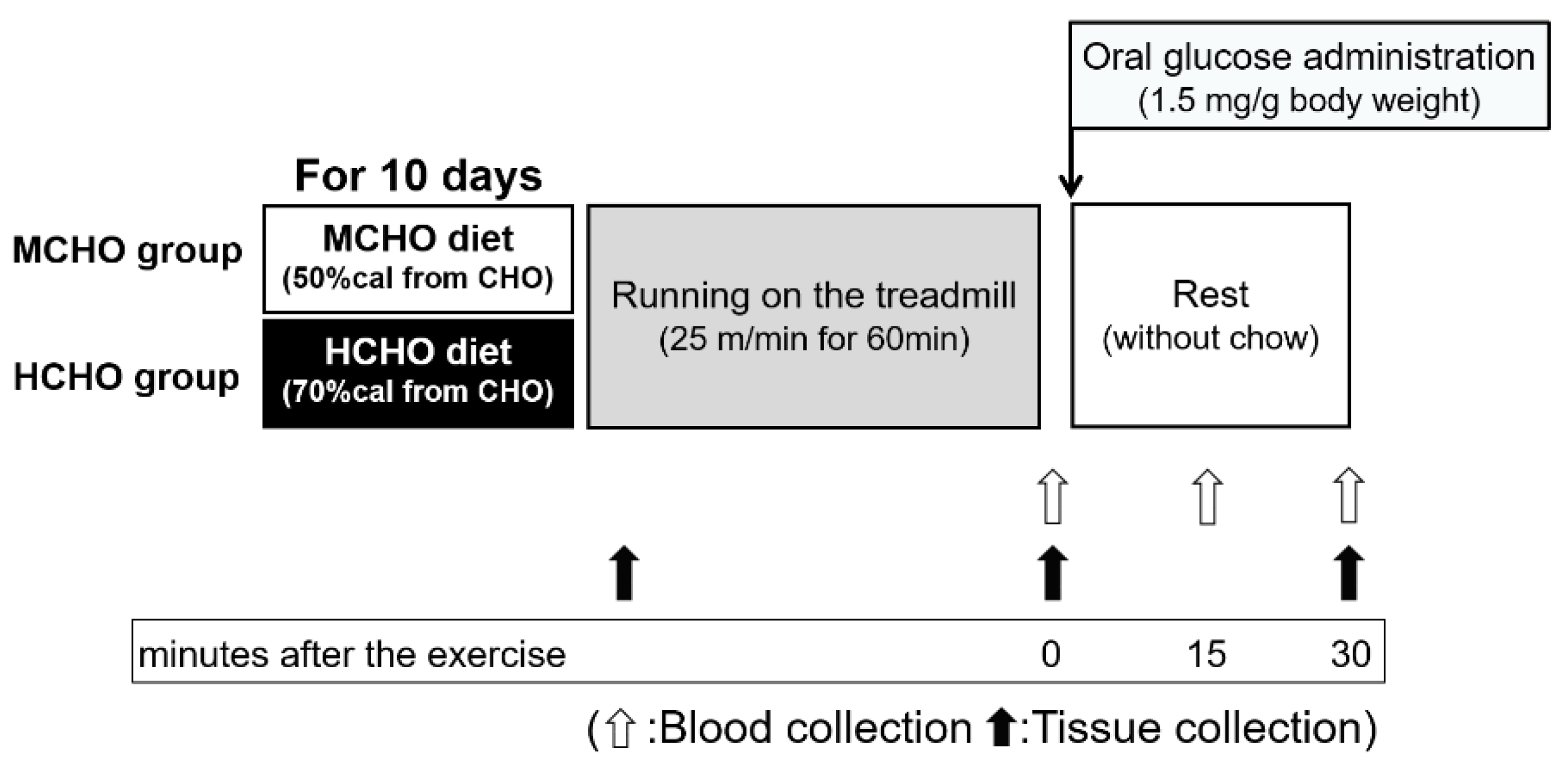

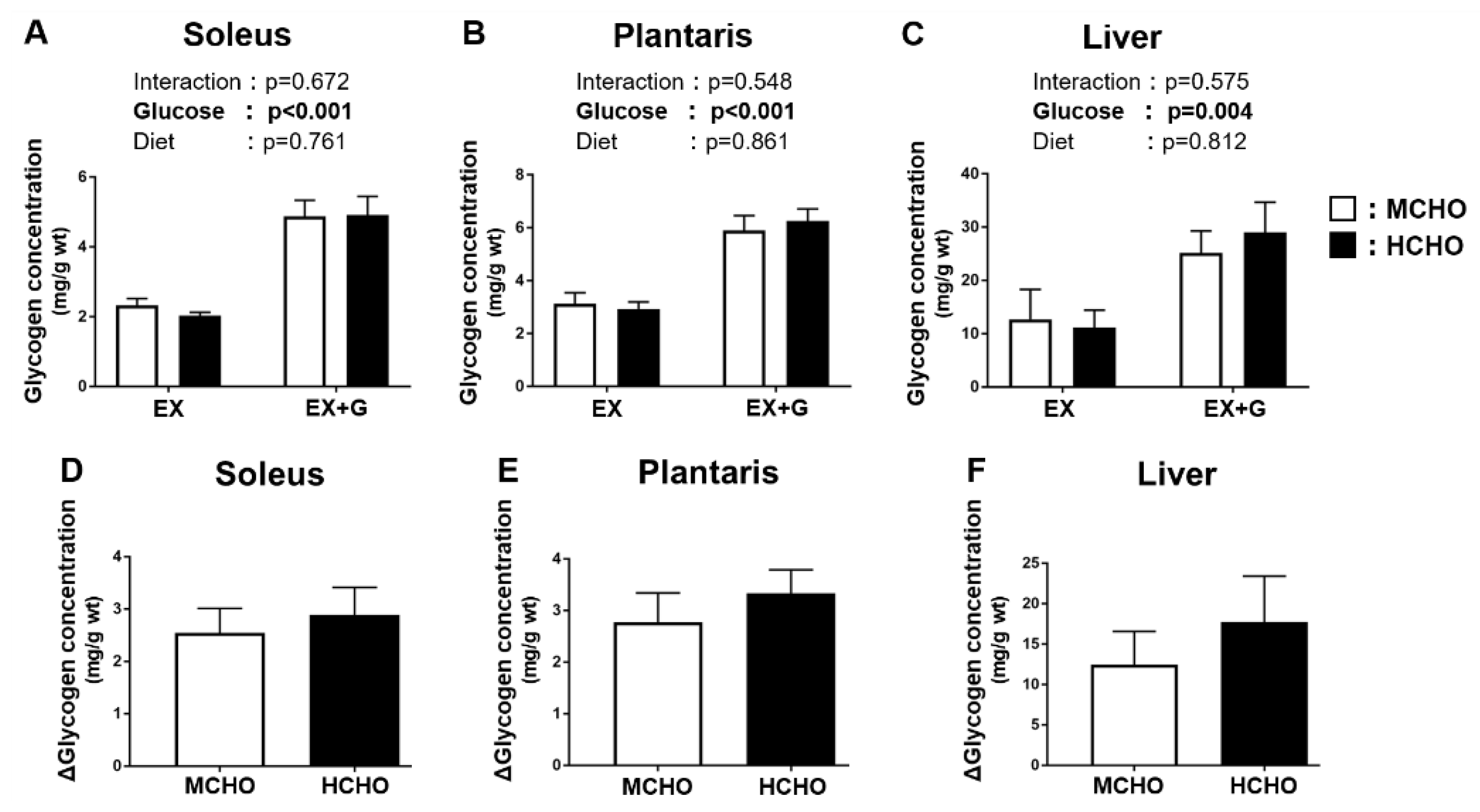

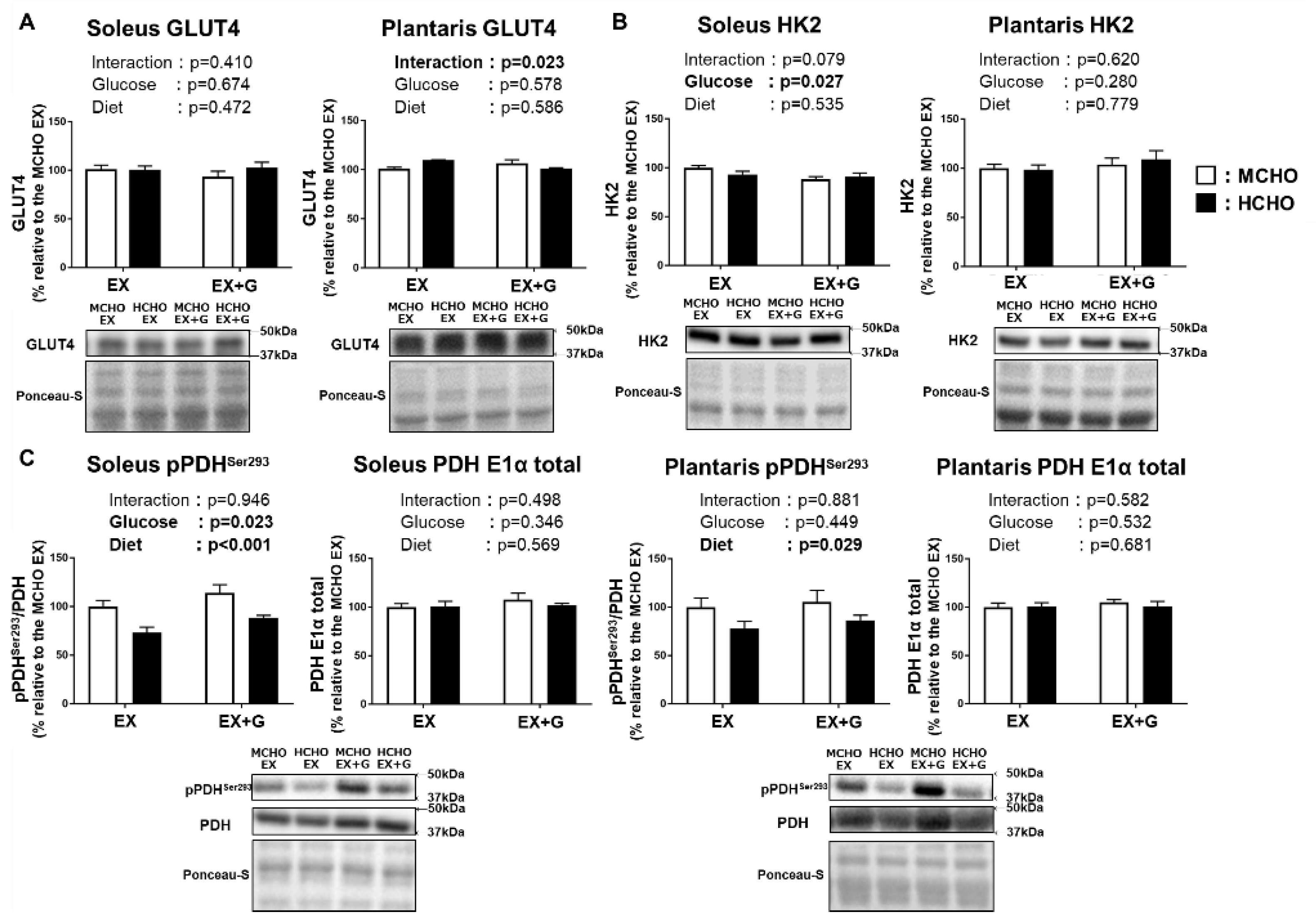
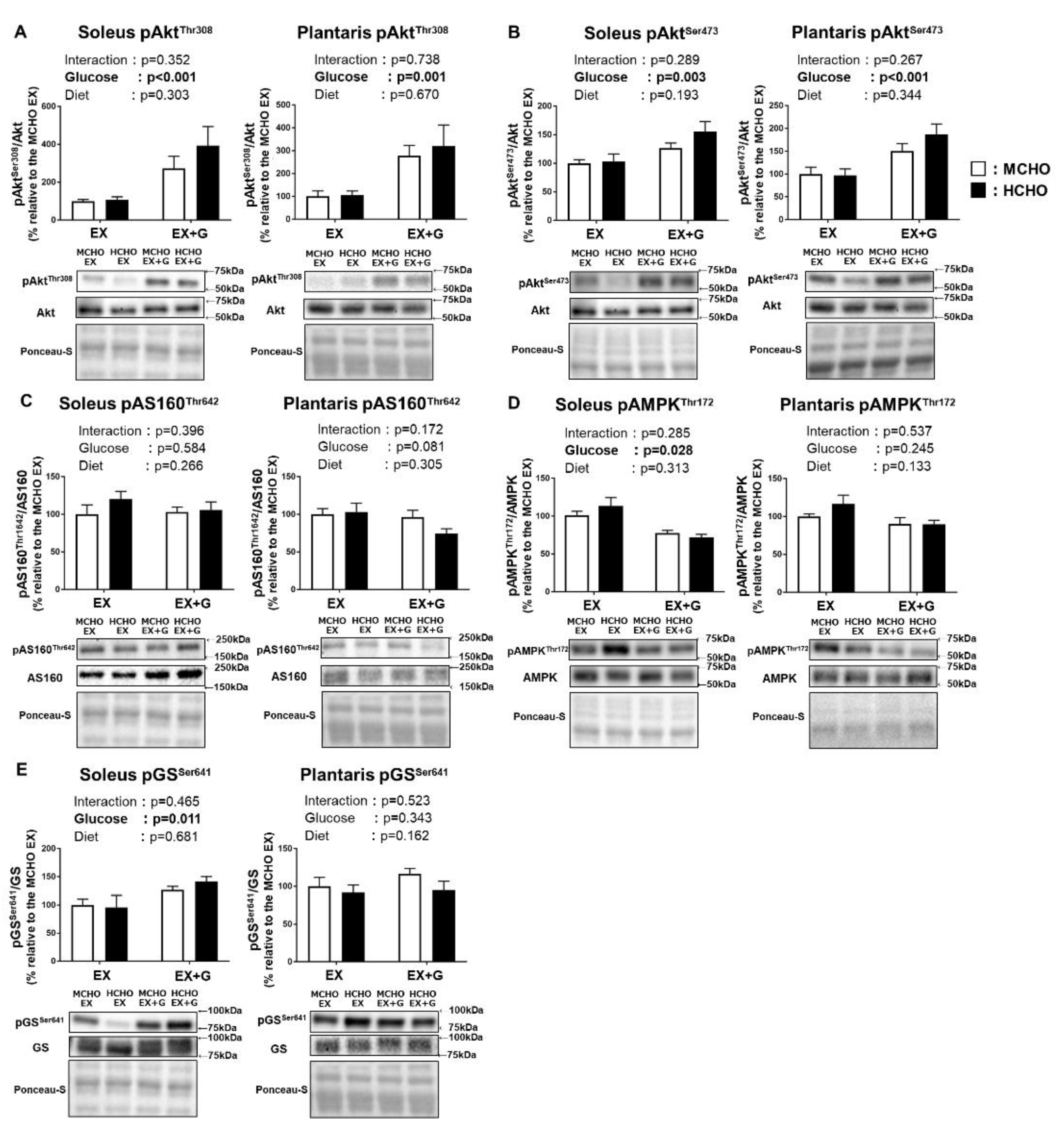
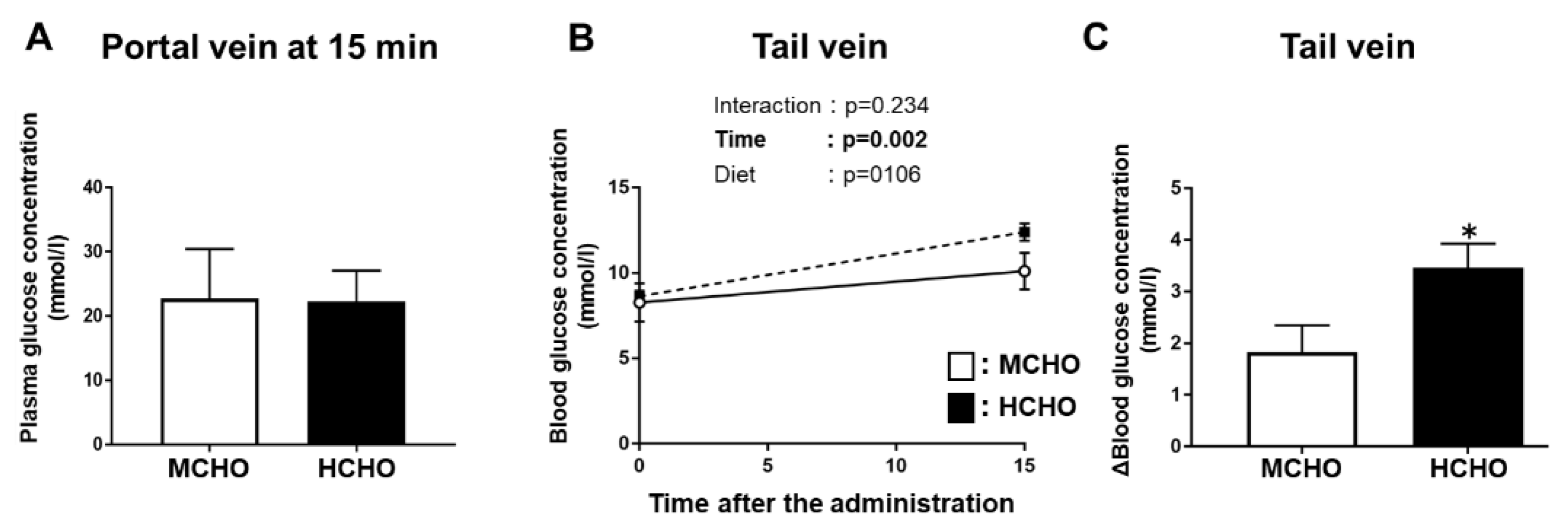
| MCHO | HCHO | |||
|---|---|---|---|---|
| Energy Content | gram% | kcal% | gram% | kcal% |
| Carbohydrate | 54.0 | 50.0 | 67.0 | 70.0 |
| Protein | 22.0 | 20.0 | 19.0 | 20.0 |
| Fat | 14.0 | 30.0 | 4.0 | 10.0 |
| Energy density (kcal/g) | 4.3 | 3.8 | ||
| Ingredient | gram | kcal | gram | kcal |
| Casein | 200.0 | 800.0 | 200.0 | 800.0 |
| L-Cystine | 3.0 | 12.0 | 3.0 | 12.0 |
| Corn starch | 303.3 | 1213.0 | 506.2 | 2025.0 |
| Maltodextrin 10 | 125.0 | 500.0 | 125.0 | 500.0 |
| Sucrose | 68.8 | 275.0 | 68.8 | 275.0 |
| Cellulose BW200 | 50.0 | 0 | 50.0 | 0 |
| Soybean oil | 25.0 | 225.0 | 25.0 | 225.0 |
| Lard | 110.2 | 992.0 | 20.0 | 180.0 |
| Mineral mix S10026 | 10.0 | 0 | 10.0 | 0 |
| Dicalcium phosphate | 13.0 | 0 | 13.0 | 0 |
| Calcium carbonate | 5.5 | 0 | 5.5 | 0 |
| Potassium citrate, 1 H2O | 16.5 | 0 | 16.5 | 0 |
| Vitamin mix V10001 | 10.0 | 40.0 | 10.0 | 40.0 |
| Choline bitartrate | 2.0 | 0 | 2.0 | 0 |
| Total | 942.3 | 4057.0 | 1055.1 | 4057.0 |
| MCHO Group | HCHO Group | |
|---|---|---|
| Initial body weight (g) | 36.1 ± 0.4 | 37.1 ± 0.7 |
| Final body weight (g) | 36.5 ± 1.4 | 37.3 ± 1.0 |
| Δ body weight (g) | 0.5 ± 1.0 | 0.2 ± 0.6 |
| Total food consumption (kcal) | 174.1 ± 8.1 | 188.6 ± 8.2 |
Publisher’s Note: MDPI stays neutral with regard to jurisdictional claims in published maps and institutional affiliations. |
© 2021 by the authors. Licensee MDPI, Basel, Switzerland. This article is an open access article distributed under the terms and conditions of the Creative Commons Attribution (CC BY) license (https://creativecommons.org/licenses/by/4.0/).
Share and Cite
Takahashi, Y.; Matsunaga, Y.; Yoshida, H.; Shinya, T.; Sakaguchi, R.; Hatta, H. High Carbohydrate Diet Increased Glucose Transporter Protein Levels in Jejunum but Did Not Lead to Enhanced Post-Exercise Skeletal Muscle Glycogen Recovery. Nutrients 2021, 13, 2140. https://doi.org/10.3390/nu13072140
Takahashi Y, Matsunaga Y, Yoshida H, Shinya T, Sakaguchi R, Hatta H. High Carbohydrate Diet Increased Glucose Transporter Protein Levels in Jejunum but Did Not Lead to Enhanced Post-Exercise Skeletal Muscle Glycogen Recovery. Nutrients. 2021; 13(7):2140. https://doi.org/10.3390/nu13072140
Chicago/Turabian StyleTakahashi, Yumiko, Yutaka Matsunaga, Hiroki Yoshida, Terunaga Shinya, Ryo Sakaguchi, and Hideo Hatta. 2021. "High Carbohydrate Diet Increased Glucose Transporter Protein Levels in Jejunum but Did Not Lead to Enhanced Post-Exercise Skeletal Muscle Glycogen Recovery" Nutrients 13, no. 7: 2140. https://doi.org/10.3390/nu13072140
APA StyleTakahashi, Y., Matsunaga, Y., Yoshida, H., Shinya, T., Sakaguchi, R., & Hatta, H. (2021). High Carbohydrate Diet Increased Glucose Transporter Protein Levels in Jejunum but Did Not Lead to Enhanced Post-Exercise Skeletal Muscle Glycogen Recovery. Nutrients, 13(7), 2140. https://doi.org/10.3390/nu13072140






